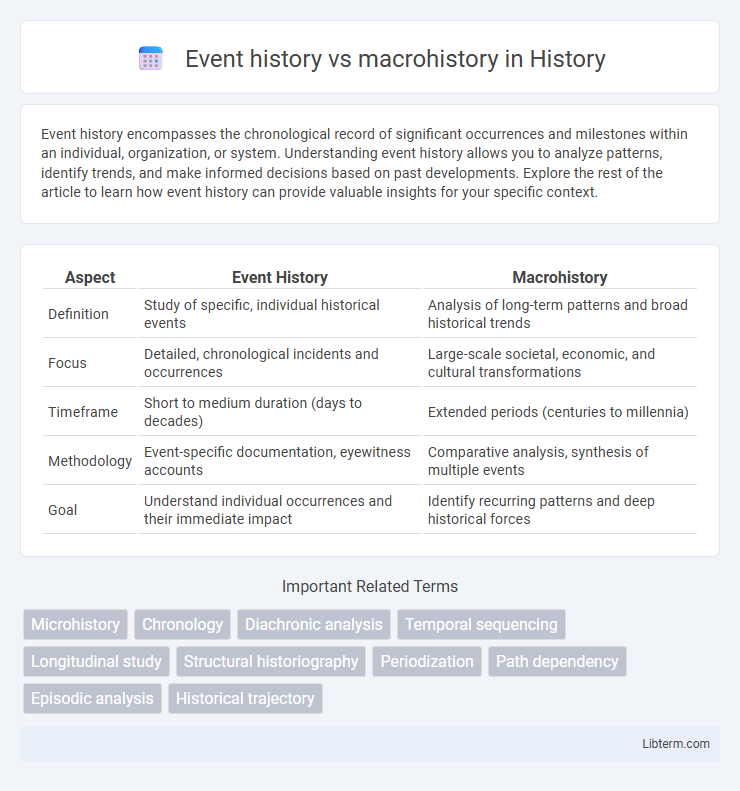Event history encompasses the chronological record of significant occurrences and milestones within an individual, organization, or system. Understanding event history allows you to analyze patterns, identify trends, and make informed decisions based on past developments. Explore the rest of the article to learn how event history can provide valuable insights for your specific context.
Table of Comparison
| Aspect | Event History | Macrohistory |
|---|---|---|
| Definition | Study of specific, individual historical events | Analysis of long-term patterns and broad historical trends |
| Focus | Detailed, chronological incidents and occurrences | Large-scale societal, economic, and cultural transformations |
| Timeframe | Short to medium duration (days to decades) | Extended periods (centuries to millennia) |
| Methodology | Event-specific documentation, eyewitness accounts | Comparative analysis, synthesis of multiple events |
| Goal | Understand individual occurrences and their immediate impact | Identify recurring patterns and deep historical forces |
Introduction to Event History and Macrohistory
Event history centers on analyzing specific occurrences within precise timelines, emphasizing short-term causes and effects using methodologies such as chronological sequencing and event mapping. Macrohistory explores broad patterns and long-term processes shaping societies and civilizations, employing comparative analysis and structural frameworks to understand systemic changes. Understanding the distinction between event history and macrohistory enables comprehensive historical insights by linking detailed events to overarching historical trends.
Defining Event History: Scope and Focus
Event history centers on the detailed analysis of specific occurrences within a defined timeframe, emphasizing their immediate causes and effects. It focuses on micro-level narratives, capturing individual events' significance and contextual nuances that shape historical outcomes. This approach contrasts with macrohistory by prioritizing granular, event-driven insights over broad, structural patterns and long-term trends.
Macrohistory: Concepts and Approaches
Macrohistory examines large-scale historical patterns and processes over extended periods, emphasizing structural forces such as economic systems, social transformations, and cultural dynamics. Key concepts include long-term social evolution, cycles of civilization rise and decline, and the analysis of civilizations or empires as holistic entities. Approaches to macrohistory integrate interdisciplinary methods from sociology, anthropology, and economics to understand overarching historical trends beyond individual events.
Key Differences Between Event History and Macrohistory
Event history emphasizes the detailed analysis of specific occurrences, focusing on precise dates and individual incidents to understand historical processes. Macrohistory explores broader patterns and long-term social, economic, or political trends, examining large-scale structures and systemic changes over extended periods. Key differences lie in scope, with event history addressing micro-level phenomena, while macrohistory investigates overarching frameworks and generalized historical dynamics.
Methodological Perspectives
Event history analysis emphasizes detailed, chronological examination of individual occurrences to understand specific causal mechanisms within historical contexts. Macrohistory adopts a broader perspective, analyzing large-scale social, economic, and political patterns over extended periods, often using quantitative data to identify structural forces and long-term trends. Methodologically, event history relies on micro-level primary sources and sequence analysis, while macrohistory integrates comparative methods and theoretical models to explain overarching historical dynamics.
Case Studies: Event History Analysis
Event history analysis provides a detailed examination of individual occurrences, tracking their timing and sequence to uncover patterns and causal relationships. Case studies utilizing event history analysis leverage time-stamped data to evaluate transitions such as life events, organizational changes, or social phenomena within specific contexts. Unlike macrohistory's broad narrative scope, event history analysis quantifies micro-level dynamics, enabling precise statistical modeling of event duration and recurrence.
Macrohistory in Global Contexts
Macrohistory in global contexts examines large-scale social, economic, and political structures over extended periods, emphasizing the interconnectedness of civilizations and empires. It prioritizes overarching patterns such as the rise and fall of global trade networks, diffusion of technologies, and transnational cultural exchanges. This approach contrasts with event history by focusing on systemic processes and global dynamics that shape historical trajectories.
Advantages and Limitations of Both Approaches
Event history analysis allows detailed examination of specific occurrences, providing precise insights into causality and temporal sequences, but it often lacks broader contextual understanding. Macrohistory offers a comprehensive overview of long-term social, economic, or political trends, capturing systemic patterns, yet it may overlook the nuanced dynamics of individual events. Combining both approaches can balance specificity with context, but integrating micro-level details into macro-level narratives remains a methodological challenge.
Impacts on Historical Interpretation
Event history concentrates on specific occurrences, providing detailed insights into individual moments that shape historical narratives, thereby enabling precise cause-and-effect analysis. Macrohistory, by examining broad patterns and structural forces over long durations, offers a comprehensive framework that contextualizes these events within larger social, economic, and political dynamics. The integration of event history with macrohistorical perspectives enhances historical interpretation by balancing granular detail with overarching trends, leading to a more nuanced understanding of historical change and continuity.
Future Directions in Historical Analysis
Event history analysis prioritizes specific occurrences and chronological sequences, providing granular insights into causality and immediate impacts. Macrohistory emphasizes broad patterns and long-term structural forces shaping societies over centuries. Future directions in historical analysis involve integrating big data analytics and computational methods to bridge micro-level event histories with macro-level trends, enhancing predictive models and fostering interdisciplinary approaches.
Event history Infographic

 libterm.com
libterm.com